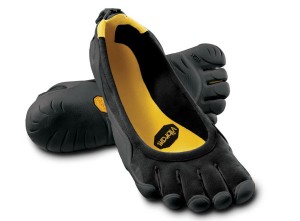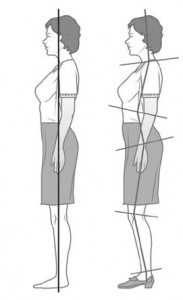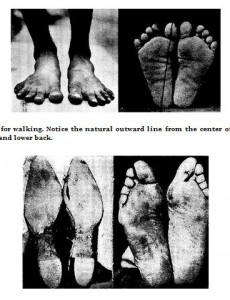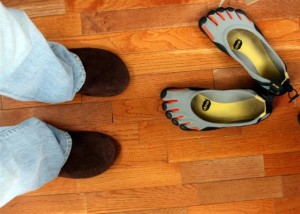You’re walking wrong!
- admin
- 0
- Posted on
 When you see someone in the shoes to the left, the words that go through your head are probably something like “Weirdo”, “Hippy”, “Hipster”, or something similar.
When you see someone in the shoes to the left, the words that go through your head are probably something like “Weirdo”, “Hippy”, “Hipster”, or something similar.
I thought that too, but as it turns out, there are actually multiple reasons for this choice of footwear. That type of footwear has two names it is typically called, Minimalist or Barefoot.
Now, while we can obviously see that it is not a bare foot, it is pretty close.
So minimalist may be a closer descriptor of the type of shoe.
Let me give you some background. Last year, I read the book 4 hour body by Tim Ferris (Fantastic Book!), and there was a section on this type of shoe, and he referenced a couple of brands like Vibram Five Fingers and VivoBarefoot. I read through it and while I found it interesting, I didn’t really give it too much thought as there were all sorts of nuggets of information in that book that I wanted to cover instead and try to implement.
A couple of months ago, my wife had asked me what I wanted for my birthday and I didn’t really have an answer. The truth is, we are very blessed and don’t “want” for a lot of things, but still want a lot of things. Typically my vice has a power cord or a battery and can do something that really wows people and can be found on Gizmodo at some point. But there wasn’t really anything out there that I wanted that fit that criteria. So I started thinking about other things I was passionate about and one of those things was health. So I decided to take Tim’s advice and get two things for my birthday.
- A Kettlebell
- A pair of minimalist (barefoot) shoes
The illustration that really stuck out to me is the one below.
The Heel
 This illustration is exactly what is wrong with the shoes that most people wear right now. They aren’t actually made for normal people to walk around on all day. Yes they are cushioned and soft and protect your feet from harm, but are they really made for our bodies or do our bodies have to conform to the idea of shoes in order make the shoes comfortable? It’s amazing that no one has asked this really in the 1000 years that we have been wearing shoes like we have today.
This illustration is exactly what is wrong with the shoes that most people wear right now. They aren’t actually made for normal people to walk around on all day. Yes they are cushioned and soft and protect your feet from harm, but are they really made for our bodies or do our bodies have to conform to the idea of shoes in order make the shoes comfortable? It’s amazing that no one has asked this really in the 1000 years that we have been wearing shoes like we have today.
As you can probably imagine, shoes are not a new idea. they all used to be flat soled, fairly thin, and were simply meant to protect the foot from both the elements, and foreign objects on the ground. But shoes that have heels can be traced all the way back to the 9th century, and were meant to help with keeping feet in the stirrups of horses. Makes sense doesn’t it?
Unfortunately that one specific function turned into fashion and became commonplace, and now all of our shoes either have the classic heel or the heel is simply higher than the toe area of the shoe, like in athletic shoes. The flat shoe is almost an oddity when you go to a shoe store and try to find one, unless you want to wear flip flops.
Not only did this fashion trend cause issues for us in terms of our joints, but it actually made us less stable than we were previously by putting too much cushion under our feet and forcing our toes to fit into a specific amount of space. Tom’s underground has a fantastic article focusing on the arch of the foot and why the arches in shoes actually make us less stable and are worse for our feet than flat soles.
The Toes
The picture on the left shows the feet of those who haven’t been constrained by shoes for 20, 40, 60 or more years versus those who have. Do you see the difference? I’m sure you can because the feet at the top aren’t “normal”. They are caveman feet, as my wife calls them. The major difference that you see right off the bat is the big toe. It is actually in line with the rest of the foot instead of being pushed to the center by conforming to the shoe’s shape.
The people without the curved toe will have better balance, and will be a lot less likely to have toe issues because their toes can grow naturally without being constrained by the shoes they have to wear.
So, with these two illustrations in mind, I started looking for shoes. I had a few criteria. The primary one was that my shoes couldn’t look anything like the picture above. I work in a typical workplace setting and I am pretty sure that if I showed up wearing something like that, it would sound some alarms throughout the building immediately. So I needed to find something that looked pretty normal. As I began looking, I found that this was harder than I thought. A lot of the designers of these shoes like to stand out and want you to notice that their shoe is different than the typical shoe. But that isn’t what I wanted. I read forum after forum about different brands and different things you needed to look for when you were doing this, and I found more information than I had ever imagined I would, but had a hard time finding normal shoes that weren’t ridiculously high.
The Criteria
So, like I mentioned above, I had pretty minimal criteria starting out, but as it turned out, after reading the forums, I had more specific criteria in regards to the way it was made and less about the design.
- No height difference between the front and back of the foot, called “zero drop”. This is better for your back as having a tilt in your shoes is bad for your back and the joints in your legs and hips. Some of the shoes have just a few millimeter drop, which is a lot better than shoes we typically wear, but still not perfect. Ideal shoes would have the zero drop.
- Something that has a large “toe box”. This is the term used for your toe area so that they can go where they want to go instead of being stuck pushed together. It’s better for balance and helps to keep you free of a lot of toe problems because your toe is getting pushed inward in all of your shoes right now.
- A thin sole. This gives you more of the feeling of being barefoot so that you can feel what is under your feet. This is better for balance, as well as gives a form of reflexology to the bottom of your foot that is better for your whole body. So you get a mini massage when you walk over something that has contours to it instead of just feeling your shoe tilt and turn underneath you. People also talk about being “more connected to the earth” and things like that, which I don’t necessarily get, but I guess that’s a bonus.
The Find
I looked at a lot of shoes, and finally came out with the shoes on the right. You can see them next to a pair of Vibram FiveFingers in that picture from Birthday Shoes. They actually look a lot like the clogs that I wear on a regular basis to work, primarily because they don’t have a back, so I can slip them off and on easily since I don’t like wearing shoes.
The shoes I decided on are actually similar to a moccasin where it doesn’t have a thick sole, and essentially just tighten around your ankle by way of elastic. They are called the Suede Roo’s, made by Soft Star Shoes. They have two different models of this shoe. One is a typical suede moccasin, and the other is a suede moccasin with a leather sole that is meant more for hard surfaces. I thought about how much I would probably wear them if I liked them and opted for the leather sole. It cost about $20 more, but I figured that if I wore them in public, I would appreciate not having to worry about the sole getting dirty or wearing out as quickly.
The Verdict
Let me just say that I absolutely love these shoes. It isn’t necessarily the shoes that I love, though I do really like these, but instead the change for my feet. I have been wearing these shoes for about two weeks now and can’t imagine going back to the typical shoe.
- My feet feel better at the end of the day, instead of being stuffed into a tight shoe. I actually forget I have shoes on once I am home because it just feels natural. Almost like having house shoes on all day.
- Oddly enough, my knees feel better, which I did not expect, because my feet aren’t being pushed forward, which isn’t hurting my knees as badly as regular shoes did. I still have bad knees, but just walking around the office doesn’t hurt them like regular shoes did. I just realized a few days ago that my knees hadn’t hurt in some time and the only change is my footwear.
And these are just the immediate changes I’ve noticed. I am sure I will notice more, and hope that my toes spread, at least a little, so that I can see if it does make a difference in the amount of stability I have compared to the way I usually am.
The Consequences
A couple of things I have noticed regarding these shoes is that once you go barefoot/minimal, it is hard going back. I have never been one to pay attention to shoes, but now that I wear these, I can’t help but think about my shoes, and what other people wear. Not only that, it makes me want more than just my one pair. I will have to purchase some that are more durable for the outdoors and for things like sports. I can’t imagine playing basketball in these, not because they wouldn’t be comfortable, but because they just aren’t made for it.
Another thing I have noticed is that when I walk a lot, my heel actually hurts. I looked into this and it is because I am walking wrong. I think a lot of people do it and don’t realize it. When we walk in shoes, we typically take very long strides that force us to put our heel on the ground before our toes touch the ground. This is actually incorrect. When we are barefoot, we don’t do that, so why should we do it when we wear shoes? I find that I do it most often when I am in a hurry. The way I should actually be walking is by taking less steps that are a little more calculated than striking my heel on the ground every step. I should either be putting the ball of my toe down or the outer edge of my foot to the ground before my heel touches. It should be more fluid and graceful than my typical caveman walk where I stomp around on my heels all the time. I think this may be part of the reason my knees don’t hurt like they did. I am forced to walk differently while barefoot compared to in shoes, so if I put my toe down first, then my knees don’t have a chance to lock back, hurting my knee further. I still have a lot of work to do to make it comfortable and normal, but I am making progress and it feels more normal everyday.
The Links
I have read a lot of good articles and want to give you the same articles I have found to look over. There is a lot of research and hard facts in these articles, as well as a lot of personal testimony. I recommend at least scanning through them to get some info.
The Case for Minimalist Footwear
10 Reasons to go Barefoot Running
The Children
I actually found quite a few links talking about how it was much better for kids to be barefoot and how it would help them later. I couldn’t find a lot of those articles when researching for this post, but I did find some of them, and there is information in the list of links above also. Some of the things I found most amazing were items like finding that our feet aren’t fully formed until later in our adolescent years. They are actually made of cartilage and turn to the 12 bones in our foot later on. So kids have more of a chance to have less foot problems if we start them early. Plus, kids are more clumsy because they can’t feel what is under their feet because of the thickness of the soles of shoes. This causes them to fall or stumble more often than normal, whereas adults have gotten used to it and know how to recover a bit better, so we don’t notice it as much.
Get Your Kids Into Minimalist Shoes to Ensure Natural Foot Development
When it Comes to Kids, Minimal can be Affordable
Healthy, Active, Barefoot Kids

